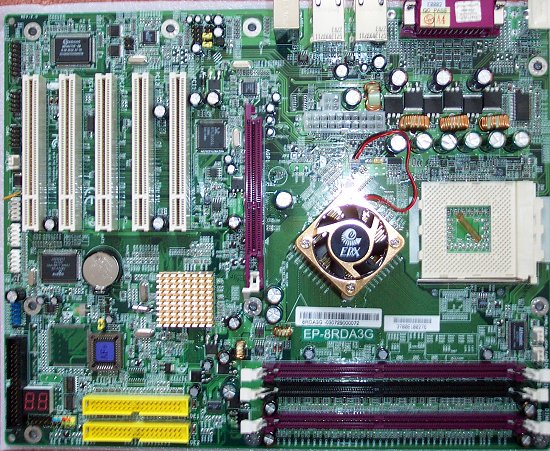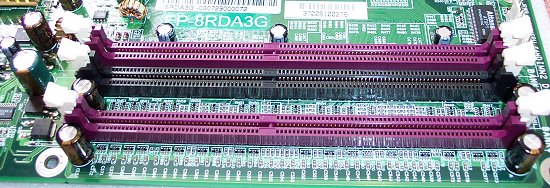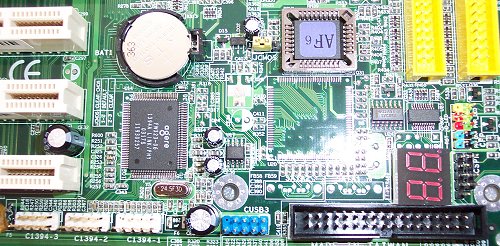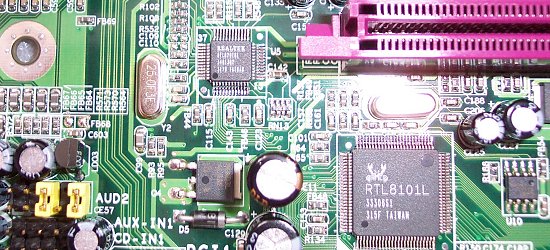Layout and features

The 8RDA3G in all its glory. The layout has generally been refined since the inception of the original nForce2 board from EPoX, the 8RDA(+). However, this one's a little different to others in a number of respects.

After the voltage adjustments available, perhaps the most important feature is the ability to mount larger coolers or waterkits on your motherboard. EPoX, thankfully, keeps the four mounting holes around the socket. This should allow one to fully exploit the voltages on offer. Right next to the mounting holes are two fan headers. Again, that's thoughtful for users who wish to mount extra cooling directed at the RAM or CPU. The extra header precludes the need for taking up a MOLEX connector. We still don't condone the use of in-socket thermistors for gauging the temperature of the CPU. Too many boards now report different temperatures for CPUs outputting similar wattage, even if the cooling is kept consistent.

The 8RDA3G is based on NVIDIA's potent nForce2 Ultra 400 chipset. Its dual-channel nature makes it the fastest Socket A solution that's currently available. EPoX gives the novice a helping hand by colouring two slots, presumably to highlight dual-channel running. Although not strictly necessary, we like to stick to 2 modules from the same manufacturer. The prevalence of dual-channel kits is testament to the rise and rise of matched memory. Architecturally speaking, the AMD Athlon cannot really make full use of the bandwidth provided by the nForce2 Ultra 400, but more is always better. Just ask Agent Smith that. Just a note on placement now. The high AGP slot position forces one to remove an AGP card before system memory can be changed. That's just a little annoying. On the upside, the gap between the AGP slot and first of five PCI slots will allow users to use upgraded coolers without compromising PCI ability.

Previously, we had applauded EPoX's use of a passive North Bridge heatsink. The 8RDA3+ had managed to hit 220FSB with ease, all with a small and passive heatsink. That's why it's not so pleasing to see the inclusion of this active version. We'll have to investigate if this helps push the board even further than previous model's performance. The location of the 20-pin main and 4-pin 12v connector is poor, subjectively speaking. The thick 20-pin connector's wires have to traverse the cooler before being plugged in. The same can be said for the 12v wire. We'd much rather see them nearer the DDR slots.

A double-take of the board informs us that the yellow IDE connectors are for the primary and secondary channels controlled by the MCP (not -T) South Bridge. There's no RAID function here, be it SATA or PATA. The silkscreened I.C position, to the right of the excellent debug display, would be where one would expect to see a Highpoint controller of some description. A fast nForce2 Ultra 400 board with a low price tag is what the 8RDA3G is all about. We'd wish that EPoX would follow ABIT's lead in specifying jumpers with oversized heads. It's quite tricky to remove and insert the jumper once the motherboard is in a case. We like the colour coded motherboard-to-case pins, shown on the right-hand side. Note that the MCP South Bridge has a passive heatsink on it. Up to 2v Vdd is sure to heat it up more than a little, and we'd recommend no more than 1.8v Vdd for daily usage.

EPoX has chosen to not use NVIDIA's South Bridge to full effect. Rather, it has gone with the MCP and routed out dual LAN ability through a Realtek PHY (RTL8201B) and Realtek single-chip solutions (RTL8101L).

The lack of COM ports opens up the ability for running video integrated into the North Bridge. Other than the dual 10/100 LAN, this is a pretty standard back panel. The six-channel sound is fed through the CMI9739A CODEC, which also offers S/PDIF-out ability, although you'll need to purchase an appropriate cable from EPoX or its distributors.









